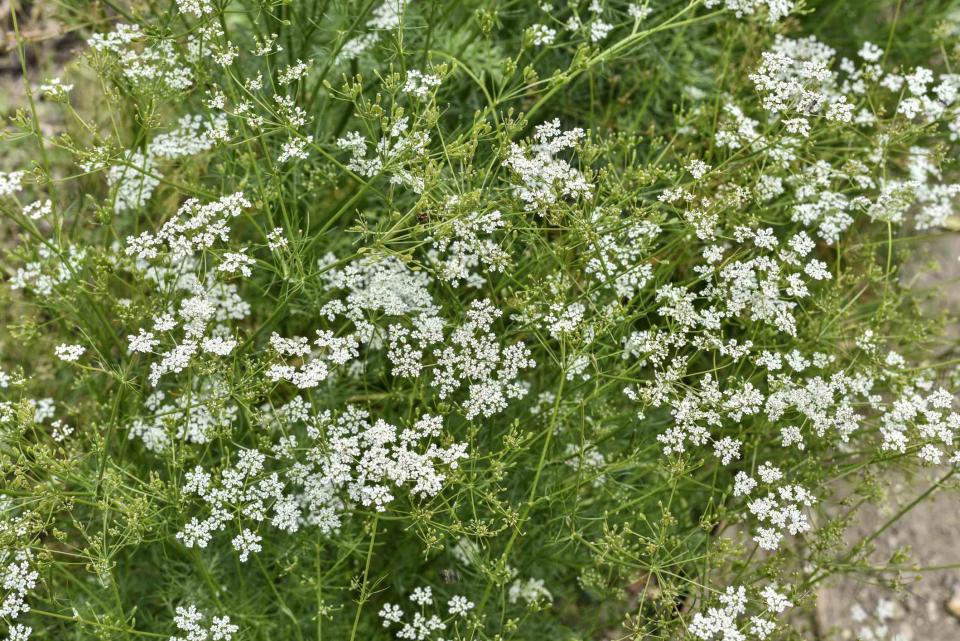How to Plant and Grow Cumin—and Harvest the Seeds for Cooking
Cumin plants make a wonderful addition to any edible garden.

Michel VIARD / Getty Images
Cumin seed is a delightful spice that is used in a wide array of recipes, from Indian curries and enchiladas to dry rubs for meat—and tossed into just about any dish where you want its unique earthy flavor. And there’s no better way to experience this aromatic spice than when harvesting it directly from your own garden.
Fortunately, growing cumin plants (Cuminum cyminum) is relatively easy. Ahead, gardening experts talk about everything you need to know for planting, growing, and harvesting this versatile plant.
Meet Our Expert
Sonya Query, master gardener, and marketing director for Love, Plants, Inc
Brandi Eide, senior director of facilities and strategic initiatives at San Diego Botanic Garden
When to Plant Cumin
You will want to wait to plant cumin until after the danger of the last frost has passed and when night temperatures are above 60 degrees Fahrenheit, says Brandi Eide, senior director of facilities and strategic initiatives at San Diego Botanic Garden. "Plants take around four months to harvest and need warm weather to properly develop," she says, adding that if you’re growing cumin in a colder climate, you may want to start seeds indoors to provide enough time to mature.
Sonya Query, master gardener and marketing director for Love, Plants, Inc., says those indoor seeds should be started around four to six weeks before the last frost date. "If starting indoors, make sure they get plenty of light (natural or a grow light), and keep seeds constantly damp until germination," says Query.
Related: How (and When) to Start Seeds Indoors to Prepare Them for Spring Planting
Where to Plant Cumin
Cumin does best in conditions that are similar to the regions it’s native to, like the Mediterranean, says Query. That means that in the U.S., cumin does best in USDA zones 5-10, she says.
When it comes to ensuring that your cumin will do well once it’s in the ground, Brandi Eide, senior director of facilities and strategic initiatives at San Diego Botanic Garden, says it’s all about giving it the best start, which includes finding the perfect spot in your garden.
"Plant in well-draining soil, with at least four to six hours of sun per day," she says, adding that your plants will need adequate watering throughout the growing season. "Soil can dry slightly between waterings, but do not let the soil stay wet or completely dry out." Amendments like mulch or organic material will help with retaining moisture.
How to Plant Cumin
Germination takes around two weeks, according to Eide, who suggests soaking seeds in water overnight before planting to speed up the process. "Plant directly in soil when possible, or minimally disturb roots if transplanting," she says, adding that you’ll want to sow your seeds shallowly (around 1/4 inch deep) and keep moist until leaves develop. "Plant heavily to harvest enough seed to utilize in your kitchen."
As for spacing, Query says you’ll want to give them plenty of room to fill out. "When planting, give each seed plenty of space to breathe—about 4 to 6 inches apart," she says.
Cumin plants grow about one to two feet high, according to Eide, who says they can look very similar to carrot tops or dill once they mature.
Fertilizing
Fortunately, cumin isn’t a heavy feeder, so you won’t have to do too much in the way of fertilizing. Eide says that while the plants appreciate "nutrient-rich soil," supplemental fertilizer is generally not necessary.
When and How to Harvest Cumin
The seed is the portion used as a spice, according to Eide. "Small umbels of flowers will form and once fertilized, seeds will develop," she says. "They will swell and turn from green to yellow/tan and split easily when ripe."
The seed will be ready to harvest around four to five months after planting. "Cut seed heads and place [them] in a paper bag to dry, clean, and harvest in one to two weeks," Eide says.
Since the seeds are where all the flavor is, Query has a great trick for ensuring that you’re able to collect all of them. "Cut the stalks with seed heads and shake or rub them over a container to collect seeds," she said. “Alternatively, you can bag the heads, let them dry, then thresh."
Once you have your bounty, Eide says you’ll need to get them ready for storage. "Ensure the seed is completely dry before storing in a sealed container to prevent mold," says Eide.
Tips
Eide says you can roast the seeds to enhance flavor, help with drying, and kill potential pests after they have been harvested.
Common Problems When Growing Cumin
When it comes to cumin, you’ll have to be on the lookout for a few hazards, like bugs and fungus. "Aphids can damage plants, manually remove or allow beneficial insects to balance populations," Eide says.
To keep those bugs at bay, Eide says you should try and plant some companion plants (like dill) that will attract beneficial insects that can help keep troublesome pests under control. "Look for beneficial ladybugs, lacewings, and wasps that are attracted to these plants," she says. "They will seek out insects like aphids on surrounding plants."
Query says you’ll also need to be on the lookout for powdery mildew, which looks like flour dusted on the leaves. "Make sure your cumin plants have good airflow and water at the root base instead of overhead," she says.
Lastly, you’ll want to beware of fusarium wilt, which Query says is a fungal pest that yellows leaves. "Prevent by rotating your crops annually—don't plant cumin or any of its family members like carrots, parsley, or celery in the same place two years in a row—and make sure your soil has excellent drainage," says Query.
Related: 10 Disease-Resistant Plants to Grow in Your Garden
Read the original article on Martha Stewart.

